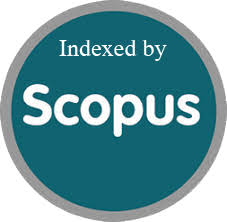Water Absorption of Foamed Concrete using Recycled Aggregate Derived from Construction and Demolition Waste
Abstract
Foam concrete (FC) is a type of lightweight concrete that has had many voides added by the foaming agent. This paper investigates the possibility of using two types of construction and demolition waste (CDWs), including thermostone blocks and ceramic tiles, as a partial replacement of sand in foam concrete to test the water absorption performance of foamed concrete. Twenty-one samples with three volume-replacement rates of sand for each waste type were explored (25, 50, and 75%). The effect of these various proportions on workability, fresh density, hardened density, and water absorption, it has been established. The results showed that the workability decreased with increasing replacement, and the density of hardened foam concrete increased. As for water absorption, it decreased at all replacement ratios as a result of filling the pores inside the foam concrete and thus increasing the bulk density. Which, in turn, reduces the permeability of foam concrete. The maximum redection in absorption and permeable voids was in the replacement of 75% of thermostone and ceramic waste powders, where the redection was 20.68% in absorption and 29.2% in permeable voids for thermostone replacement, the absorption value was 15.96%, and the permeable voids were 38.28% for ceramic.
References
- A. A. Jhatial, W. I. Goh, N. Mohamad, L. W. Hong, M. T. Lakhiar, A. A. Abdul Samad, R. Abdullah, The mechanical properties of foamed concrete with polypropylene fibres. International Journal of Engineering & Technology. 7 (3.7) (2018) 411-413.
- A. Gonzalez-Corominas, M. Etxeberria, Properties of high performance concrete made with recycled fine ceramic and coarse mixed aggregates. Construction and Building Materials. 68 (2014) 618-626, doi: https://doi.org/10.1016/j.conbuildmat.2014.07.016
- A. Heidari, D. Tavakoli, A study of the mechanical properties of ground ceramic powder concrete incorporating nano-SiO2 particles. Construction and Building Materials. 38 (2013) 255264, doi: https://doi.org/10.1016/j.conbuildmat.2012.07.110
- A. M. Barrios, D. F. Vega, P. S. Martnez, E. Atanes-Snchez, C. M. Fernndez, Study of the properties of lime and cement mortars made from recycled ceramic aggregate and reinforced with fibers. Journal of Building Engineering. 35 (2021) 1-10, doi: https://doi.org/10.1016/j.jobe.2020.102097
- A. S. Hasan, O. M. Ali, A. A. Hussein, Comparative study of the different materials combinations used for roof insulation in Iraq. Mater. Tod. Proce. 42 (2021) 22852289, https://doi.org/10.1016/j.matpr.2020.12.317.
- ASTM C642: Standard test method for density, absorption, and voids in hardened concrete, 1997, American Society for Testing and Materials, doi: 10.1520/C0642-21
- B. Kado, S. Mohammad, Y. H. Lee, P. N. Shek, M. A. Ab Kadir, Effect of curing method on properties of lightweight foamed concrete. Int. Jour. Eng. Tech. 7 (2.29) (2018) 927-932, https://doi.org/10.14419/ijet.v7i2.29.14285
- BS EN 12350-6: Testing fresh concrete density part 6, 2019, British and European Standard, doi: https://doi.org/10.3403/BSEN12350
- D. Yang, M Liu, Z. Zhang, P. Yao, Z. Ma, Properties and modification of sustainable foam concrete including eco-friendly recycled powder from concrete waste. Case Stud. Const. Mater. 16 (2022) e00826, https://doi.org/10.1016/j.cscm.2021.e00826.
- E. Eltayeb, X. Ma, Y. Zhuge, O. Youssf, J. E. Mills, Influence of rubber particles on the properties of foam concrete. J. Build. Eng. 30 (2020) 101217, https://doi.org/10.1016/j.jobe.2020.101217.
- E. K. K. Nambiar, K. Ramamurthy, Shrinkage behavior of foam concrete. Journal of Materials in Civil Engineering. 21 (2009) 631-636, doi: https://doi.org/10.1061/(ASCE)0899-1561(2009)21:11(631)
- EN 12350: Testing fresh concrete part 8: Self-compacting concrete slump flow test, 2008, European Standard.
- EN 12390-7: Testing hardened concrete density part 7, 2019, European Standard.
- F. Iucolano, A. Campanile, D. Caputo, B. Liguori, Sustainable management of autoclaved aerated concrete wastes in gypsum composites. Sust. 13 (2021) 3961. https://doi.org/10.3390/su13073961.
- F. K. Abdulhussein, Q. J. Frayyeh, M. S. Al-Shaikhli, Z. F. Jawad, M. M. Salman, Behaviour of thermostone blocks with and without cement mortar plastering exposed to high temperatures. Journal of Applied Engineering Science. 19 (2) (2021), 800, 356-362, doi: https://doi.org/10.5937/jaes0-28742
- G. Calis, S. A. Yildizel, S. Erzin, B. A. Tayeh, Evaluation and optimisation of foam concrete containing ground calcium carbonate and glass fibre (experimental and modelling study). Case Studies in Construction Materials. 15 (2021) e00625, doi: https://doi.org/10.1016/j.cscm.2021.e00625
- G. F. Huseien, A. R. M. Sam, K. W. Shah, J. Mirza, Effects of ceramic tile powder waste on properties of self-compacted alkali-activated concrete. Construction and Building Materials. 236 (2020) 117574, doi: https://doi.org/10.1016/j.conbuildmat.2019.117574
- H . El-Didamony, A. A. Amer, M. S. Mohammed, M. Abd El-Hakim, Fabrication and properties of autoclaved aerated concrete containing agriculture and industrial solid wastes. Journal of Building Engineering. 22 (2019) 528-538, doi: https://doi.org/10.1016/j.jobe.2019.01.023
- H. Gao, W. Wang, H. Liao, F. Cheng, Characterization of light foamed concrete containing fly ash and desulfurization gypsum for wall insulation prepared with vacuum foaming process. Constr. Build. Mater. 281 (2021) 122411, https://doi.org/10.1016/j.conbuildmat.2021.122411.
- How to stop 20m tons of construction industry waste going to landfill each year (no date) RMIT University. Available at: https://www.rmit.edu.au/news/all-news/2019/jul/construction-industry-waste-landfill (Accessed: 17 August 2023).
- J. F. Castillo-Lara, E. A. Flores-Johnson, A. Valadez-Gonzalez, P. J. Herrera-Franco, J. G. Carrillo, P. I. Gonzalez-Chi, Q. M. Li, Mechanical properties of natural fiber reinforced foamed concrete. Materials. 13 (3060) (2020) 1-18, doi: https://doi.org/10.3390/ma13143060
- J. Newman, B. S. Choo, Advanced Concrete Technology-Processes, Elsevier Ltd, 1st edition, 2003.
- J. R. Jimnez, J. Ayuso, M. Lpez, J. M. Fernndez, J. Brito, Use of fine recycled aggregates from ceramic waste in masonry mortar manufacturing. Construction and Building Materials. 40 (2013) 679-690, doi: https://doi.org/10.1016/j.conbuildmat.2012.11.036
- K. Ramamurthy, E. K. K. Nambiar, G. I. S. Ranjani, A classification of studies on properties of foam concrete. Cem. Concr. Compos. 31 (2009) 388396, https://doi.org/10.1016/j.cemconcomp.2009.04.006.
- K. Rashid, A. Razzaq, M. Ahmad, T. Rashid, S. Tariq, Experimental and analytical selection of sustainable recycled concrete with ceramic waste aggregate. Construction and Building Materials. 154 (2017) 829-840, doi: https://doi.org/10.1016/j.conbuildmat.2017.07.219
- K. W. Shah, G. F. Huseien, Recycled Ceramics in Sustainable Concrete: Properties and Performance, CRC Press and Taylor & Francis Group, 1st edition, 2021, doi: https://doi.org/10.1201/9781003120292
- L. Gautam, J. K. Jain, P. Kalla, S. Choudhary, A review on the utilization of ceramic waste in sustainable construction products. Materials Today: Proceedings. 43 (2021) 1884-1891, doi: 10.1016/j.matpr.2020.10.829
- M. A. Gawad, N. M. Fawzi, Use of thermostone waste aggregates for internal curing of reactive powder concrete. IOP Conf. Series: Earth andEnvironmental Science 877 (2021), Proceedings of the 7th International Conference on Renewable Energy and Materials Technology (ICOREMT 2021), Erbil, Iraq 012043. (2021) 1-16, doi: 10.1088/1755-1315/877/1/012043
- M. Amran, R. Fediuk, N. Vatin, Y. H. Lee, G. Murali, T. Ozbakkaloglu, S. Klyuev, H. Alabduljabber, Fibre-reinforced foamed concretes: A review. Materials. 13 (4323) (2020) 1-36, doi: https://doi.org/10.3390/ma13194323
- M. Limbachiya, M. S. Meddah, S. Fotiadou, Performance of granulated foam glass concrete. Construction and Building Materials, 28 (2012) 759-768. DOI:10.1016/j.conbuildmat.2011.10.052
- N. N. Lam, Recycling of AAC waste in the manufacture of autoclaved aerated concrete in Vietnam. International Journal of GEOMATE. 20 (2021) 128-134, doi: 10.21660/2021.78.j2048
- N. Tazi, R. Idir, A. B. Fraj, Sustainable reverse logistic of construction and demolition wastes in French regions: Towards sustainable practices. Procedia CIRP. 90 (2020) 712717, doi: https://doi.org/10.1016/j.procir.2020.01.126
- O. Gencel, M. Oguz, A. Gholampour, T. Ozbakkaloglu, Recycling waste concretes as fine aggregate and fly ash as binder in production of thermal insulating foam concretes. Journal of Building Engineering. 38 (2021) 102232, doi: https://doi.org/10.1016/j.jobe.2021.102232
- O. H. Oren, A. Gholampour, O. Gencel, T.Ozbakkaloglu, Physical and mechanicalproperties of foam concretes containinggranulated blast furnace slag as fine aggregate.Construction and Building Materials. 238(2020) e01038, doi: 10.1016/j.conbuildmat.2019.117774
- O. Y. Bayraktar, H. Soylemez, G. Kaplan, A. Benli, O. Gencel, M. Turkoglu, Effect of cement dosage and waste tire rubber on the mechanical, transport and abrasion characteristics of foam concretes subjected to H2SO4 and freezethaw. Construction and Building Materials. 302 (2021) 124229, doi: https://doi.org/10.1016/j.conbuildmat.2021.124229
- P. O. Awoyera, B. F. Britto, Foamed concrete incorporating mineral admixtures and pulverized ceramics: Effect of phase change and mineralogy on strength characteristics. Construction and Building Materials. 234 (2020) 117434, doi: 10.1016/j.conbuildmat.2019.117434
- P. O. Awoyera, J. M. Ndambuki, J. O. Akinmusuru, D. O. Omole, Characterization of ceramic waste aggregate concrete. HBRC Journal. 14 (2018) 282-287.https://doi.org/10.1016/j.hbrcj.2016.11.003
- P. Rubio de Hita, F. Prez-Glvez, M. J. Morales-Conde, M. A. Pedreo-Rojas, Characterisation of recycled ceramic mortars for use in prefabricated beam-filling pieces in structural floors. Materiales de Construccin. 69 (2019) 1-19, doi: https://doi.org/10.3989/mc.2019.04518
- R. A. Rahman, A. Fazlizan, N. Asim, A. Thongtha, Utilization of waste material for aerated autoclaved concrete production: A preliminary review. IOP Conf. Series: Earth and Environmental Science 463 (2020) 012035, International Conference on Sustainable Energy and Green Technology, 2019, Bangkok, Thailand. (2020) 1-9, doi: https://doi.org/10.32604/jrm.2021.013296
- R. T. Lermen, G. Bonatto, R. A. Silva, Useof foundry green sand waste in development offoamed concrete. Revista de ArquiteturaIMED. 9 (2020) 153-170, doi: https://doi.org/10.55905/revconv.17n.1-060
- R. V. Meena, J. K. Jaina, H. S. Chouhan, A. S. Beniwal, Use of waste ceramics to produce sustainable concrete: A review. Clea Mater. 4 (2022) 100085, https://doi.org/10.1016/j.clema.2022.100085.
- R. Wang, P. Gao, M. Tian, Y. Dai, Experimental study on mechanical and waterproof performance of lightweight foamed concrete mixed with crumb rubber. Construction and Building Materials. 209 (2019) 655-664, doi: https://doi.org/10.1016/j.conbuildmat.2019.03.157
- S. FAlfuady, Y. Idris, Characteristics foam concrete with polypropylene fiber and styrofoam. IOP Conf. Series: Journal of Physics: Conf. Series 1198, SENTEN 2018-Symposium of Emerging Nuclear Technology and Engineering Novelty, (2019) 082020, IOP Publishing, doi: 10.1088/1742-6596/1198/8/082020
- S. Ray, M. Haque, N. Sakib, A. Mita, M. Rahman, B. B. Tanmoy, Use of ceramic wastes as aggregates in concrete production: A review. Journal of Building Engineering. 43 (2021) 1-27, doi: https://doi.org/10.1016/j.jobe.2021.102567
- T. Li, F. Huang, J. Zhu, J. Tang, J. Liu, Effect of foaming gas and cement type on the thermal conductivity of foamed concrete. Constr. Build. Mater. 231 (2020) 117197, https://doi.org/10.1016/j.conbuildmat.2019.117197.
- T. Suwan, P. Wattanachai, Properties and internal curing of concrete containing recycled autoclaved aerated lightweight concrete as aggregate. Advances in Materials Science and Engineering. 2017 (2017) 111, doi: https://doi.org/10.1155/2017/2394641
- V. Lesovik, V. Voronov, E. Glagolev, R. Fediuk, A. Alaskhanov, Y. H. M. Amran d, G. Murali, A. Baranov, Improving the behaviors of foam concrete through the use of composite binder. J. Build. Eng. 31 (2020) 101414, https://doi.org/10.1016/j.jobe.2020.101414.
- W. She, Y. Du, G. Zhao, P. Feng, Y. Zhang,X. Cao, Influence of coarse fly ash on the performance of foam concrete and its application in high-speed railway roadbeds. Construction and Building Materials. 170 (2018) 153-166, doi: 10.1016/j.conbuildmat.2018.02.207
- W. Tao1, H. Xingyang, Y. Jin, Z. Huang, S. Ying, Nano-treatment of autoclaved aerated concrete waste and its usage in cleaner building materials. Jour. Wuh. Univ. Tech. Mater. Sci. Ed. 35 (4) (2020) 786793, https://doi.org/10.1007/s11595-020-2321-6
- Y. Peng, X. Yuan, L. Jiang, J. Yang, Z. Liu, Y. Zhao, H. Chen, The fabricating methods, properties and engineering applications of foamed concrete with polyurethane: a review. International Journal of Environmental Science and Technology. (2022) 1-20, doi:
- Z. A. Shareef, S. Y. Ahmed, O. M. Abdulkareem, Potential Use of Wastes of Thermostone Blocks and Ceramic Tiles as Recycled Aggregates in Production of Foam Concrete. Civil Engineering and Architecture. 11 (2023) 1280-1296, doi: 10.13189/cea.2023.110314
- Z. Gyurk, B. Jankus, O. Fenyvesi, R. Nemes, Sustainable applications for utilization the construction waste of aerated concrete. Jour. Clea Prod. 230 (2019) 430444, https://doi.org/10.1016/j.jclepro.2019.04.357.
- Z. Keshavarz, D. Mostofinejad, Porcelain and red ceramic wastes used as replacements for coarse aggregate in concrete. Constr. Build. Mater. 195 (2019) 218230, https://doi.org/10.1016/j.conbuildmat.2018.11.033.








